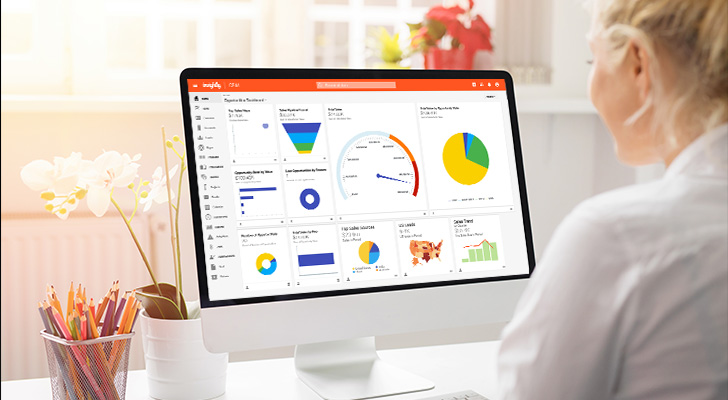It’s not easy being in customer service.
In addition to solving customer problems, customer service professionals need to deliver a positive customer experience in everything they do, whether it’s offering technical support, sharing additional information to help customers maximize their investment in your product, or simply listening with empathy.
Customer service professionals need to perform to the best of their abilities for the good of the customer and the company.
But how can you evaluate whether or not your customer service is effective? The answer is Key Performance Indicators (KPIs), which can give you critical insights into your customer service team’s performance and provide you with actionable and practical paths towards success.

Tracking customer service KPIs is essential
There’s no debate between the benefits of intuition vs. data. Data-based decision making uses quantitative measuring to make crucial business decisions.
KPIs empower you to better understand the health and performance of your customer service practices so you can guide your team in reaching your company’s benchmarks and goals.
The benefits of KPIs include:
- Sharpening business insights
- Improving customer satisfaction
- Measuring efficiency
- Strengthening customer retention
When you focus on customer service-based KPIs, you can achieve results quicker and gain critical insights into buyer interactions. You will also help your customer support team identify and gauge customer loyalty and customer retention patterns.
How to choose the right customer service KPIs
When you identify and measure your customer service teams with KPIs, you commit to helping your company efficiently analyze and monitor the entire customer journey.
Let’s look at the best metrics and types of customer support KPIs you can use to accurately measure customer service practices.
Customer satisfaction KPIs
Customer satisfaction KPIs measure how your customers feel about your company and the quality of their interactions with you and your customer service team.
The following are the best KPIs to track and measure how satisfied your customers are with your company and their customer journey:
1. Net Promoter Score (NPS)
The NPS is a metric that helps you measure customer enthusiasm, satisfaction, and customer loyalty. You can calculate the Net Promoter Score by asking customers to rate their likelihood of recommending your company, product, or service on a scale of 1 to 10.
Why it matters:
You can use the NPS to determine business growth opportunities. A high NPS shows a healthy relationship with your customers, while a low one indicates there are issues with customer relationships that you need to address.
How it helps:
While the NPS alone isn’t enough to paint a complete picture of your customer’s loyalty, it allows you to quantify the data over time to create internal benchmarks.
You can also use it to rally your employees around creating an enthusiastic customer base because your teams can see the impact they have on customers.
2. Customer Satisfaction Score (CSAT)
The Customer Satisfaction Score is a metric that measures customer satisfaction levels throughout the customer experience.
This data comes from customer feedback surveys that ask questions about their satisfaction with your product, service, or brand as a whole. The CSAT score can range from 0 to 100%.
Why it matters:
The CSAT is a strong indicator of your customer loyalty and overall customer experience because it tells you how happy your customers are with your company.
It also helps you identify the steps your need to take to increase your retention rates and improve your brand’s reputation.
How it helps:
The KPI gives your company a cumulative view of customer support to deliver goods and services for you to compare and contrast over an extended period.
3. Customer Effort Score (CES)
The Customer Effort Score allows service organizations to analyze how easy it is for customers to interact with your customer support team to resolve their issues.
The CES asks one question and then scores the responses on a numeric scale with one being the highest level of disagreement.
Why it matters:
Boosting customer loyalty is essential, but there is a more significant opportunity by keeping customers from becoming disloyal.
Disloyal or dissatisfied customers are much more likely to negatively impact your company in a variety of ways.
How it helps:
The CES analyzes the amount of effort your customers have to exert during their interactions with your service agents.
You can use this metric to gauge and adjust your processes to achieve a highly satisfactory and low-effort experience for your customers.

KPIs for Customer Service Performance: Teams and Individual Agents
Your customer support team is the face of your company in post-sale interactions. They are often the first ones to interact with new customers, which means their performance will reflect on your business and reputation.
Companies need to make sure their customer service experience is second to none. And to do this, customer support teams need access to key metrics that will help them identify areas of strength and improvement.
4. First Response Time (FRT)
Also known as Time to First Response, this metric measures the minutes, hours, or days it takes from the moment a customer submits a support ticket to when customer service reps respond.
To find your average time to first response, identify the total number of tickets within a selected timeframe and divide the total time it took your team to send the first response.
Why it matters:
Your Time to First Response plays a critical role in enhancing customer satisfaction levels. Your clients want a prompt response to their support requests so your team’s performance makes a big impact.
How it helps:
Identifying your Time to First Response will help you set a baseline for support ticket response times. In addition, it can help you develop a timeframe benchmark for your customer service reps.
5. Average Handle Time (AHT)
The Average Handle Time identifies the time it takes for a customer to finish their interaction with your customer support team from when they start the call to when they hang up. This KPI includes hold time, talk time, and any other idle time during the call.
To find the AHT, add the total hold time, talk time, and after-call task time. Next, divide that time by the number of calls your team received during that time frame.
Why it matters:
Once customers start the resolution process, they want it to go as quickly as possible. No one likes to wait for a solution to their issue. The longer your customers have to wait for a resolution, the more likely they are to become dissatisfied and end the call.
A discontented customer can make a negative impact on your business, so it’s crucial to identify and put practices in place to avoid long resolution times.
How it helps:
Finding your Average Handle Time will allow you to compare it with your industry benchmark times to ensure you are on par with your competitors.
It also provides a benchmark to strive towards, which will motivate your customer service team to meet their call time goals.
6. Ticket Resolution Rate (TRR)
The Ticket Resolution Rate is a metric that compares the number of tickets your representative or team receives with the number of tickets they resolve within a particular time.
To determine the TRR, divide the number of tickets your team solves by the number of tickets they receive. Next, multiply that number by 100 to identify the resolution rate.
Why it matters:
Ticket resolution rates are subjective to your industry; however, every business knows they need to solve any customer issues quickly and efficiently.
Your customers need to know you care about their time and problems, so offering a quick ticket turnaround time dramatically improves the customer experience.
How it helps:
Identifying your ticket resolution rate will help you compare your company with others in your industry and assist your customer support team with identifying the areas they need to improve.

7. First Contact Resolution Rate (FCR)
The FCR is an essential customer service metric because it measures how many customer contacts your team resolves within a single interaction with the customer.
If your company resolves the customer issue on the first contact, your customers won’t need to call again or require the representative to follow up. Improving your FCR increases customer satisfaction and improves customer loyalty.
Why it matters:
There are many ways to measure the performance of your contact center so it’s important to find the right metrics.
To boost customer satisfaction, your customer support representatives need to view customer contacts as an escalation and have a strong desire to deliver prompt, effective resolutions.
How it helps:
The FCR is a straightforward way for you to experience your support team’s interactions through your customer’s perspective.
Call centers that honor the reality of customer contact allows them to surpass the expectations and requirements of the customer, which leads to a more satisfying customer service experience.
8. Identify your top performing agents
When you combine multiple KPIs, like conversion rates, customer satisfaction surveys, and call response times, and sort them by the representative, you’ll be able to identify which of your customer support reps are performing well and which are not.
Why it matters:
Your representatives want you to recognize their accomplishments. They also want to clearly understand the expectations of their roles.
How it helps:
Positive reinforcement by rewarding top-performing representatives will ensure adequate staffing and encourage employee engagement.

Operational customer service KPIs
Operational KPIs measure company efficiency in your day-to-day operations. These key metrics help identify which strategies during daily operations need improvement and which are working well.
Here are the most important customer service KPIs to ensure your support operations are running smoothly.
9. Tickets by channel
This metric identifies how many tickets your customers generate through various channels, such as your website, phone calls, or chatbots.
Why it matters:
Whether you operate through customer service apps or live call centers, knowing where your customers are looking for assistance is crucial.
To meet the needs of your customers, you must be sure to have the optimal resourcing in the right places.
How it helps:
Seeing where your tickets are coming from will help you target where you need to focus and improve your customer service efforts.
10. Tickets by customer
Use this metric to determine if any of your customers need to repeatedly reach out to your customer service team.
Having to keep contacting support will lead to customer dissatisfaction and lead to a reduction in customer retention.
Why it matters:
If a customer generates multiple help tickets, you’ll know there is a problem to pinpoint and solve as soon as possible to avoid customer frustration.
How it helps:
Using this metric can help you determine which product or service is causing the customer to generate multiple tickets. Then you can set actionable goals to resolve the issue and stop multiple help tickets.
11. Tickets by category
Sorting tickets by category allows you to see which areas of your business result in higher amounts of customer inquiries or tickets.
Knowing where to focus on improvements can help you improve the customer experience and raise customer retention rates.
Why it matters:
Much like sorting tickets by the customer, identifying how many tickets your customers are generating per category shows you the key areas you need to address.
Faster resolution for customers will raise customer satisfaction and loyalty.
How it helps:
Automating the ticket categorization process can make it easier for your customer support agents to handle tickets by routing rules and knowledge sets.

How your customer service efforts impact higher level metrics and KPIs
Every customer touchpoint is an opportunity to build your customer relationships and increase profits. Since your representatives are the first point of contact for questions and concerns, they play a significant role in your user experience (UX).
Sometimes, customer service efforts can impact higher-level metrics and KPIs. Surprisingly, the following KPIs and metrics that may not seem connected to customer service can act as a litmus test for whether or not your customer service makes a positive impact on your customers.
12. Customer Retention Rate (CRR)
Customer Retention Rate (CRR) measures the number of customers a business retains over a specific period.
To identify your CRR, begin with the number of customers at the end of a given period and subtract it from the number of new customers during that same period. Next, divide this number by the number of customers at the beginning of that period and multiply it by 100.
Why it matters:
Onboarding new customers improves your overall brand, but retaining them for the long haul shows you have cultivated a solid relationship of trust and loyalty.
How it helps:
Tracking your customer retention and churn rates will help you build unique, long-lasting relationships with your clients. It also demonstrates they trust you and your brand gives them value.
13. Customer Lifetime Value (CLV)
Some businesses abbreviate this KPI as CLTV or LTV. It identifies the net profit your company has contributed to the entire relationship lifecycle of a specific customer.
Essentially, this metric lets you know how much it costs you to retain a client as well as the revenue they bring to your business. To calculate your CLV, subtract the lifetime customer costs from the lifetime customer revenue.
Why it matters:
Successful businesses use CLV to guide their business decisions and identify where to focus their marketing efforts. This gives them valuable insight into which customer segments are the most profitable.
How it helps:
Knowing which customers are bringing in the most revenue will help your customer service team focus on maintaining positive relationships with those clients.
14. Monthly Recurring Revenue (MRR)
The MRR is a KPI that identifies the revenue a company can accurately predict it receives every month. It’s the amount of income existing customers generate.
Calculate the MRR growth metric by adding the additional revenue from current clients that occurred within a given month.
Why it matters:
This metric is essential to understanding your overall business cash flow and profitability. Your KPI can help you monitor your business profits and make changes before your revenue sinks too low.
How it helps:
Tracking MRR and MRR growth will give you a better idea of how your company is performing right now with current customers. It may shed light on customer service practices that are working well and some that may need improvement.

15. Contract Renewal Rate (CRR)
Your company’s contract renewal rate is the percentage of customers that renew their contracts or subscriptions with your business. This metric shows you how many customers are satisfied enough to extend their relationship with your business.
Determine your contract renewal rate by dividing the number of contract renewals by the number of eligible members within a specific period.
Why it matters:
Happy customers will renew their contracts. If your contract renewal rate is low or dips, it could indicate that you need to make some changes to your customer service procedures.
How it helps:
Evaluating this metric regularly will help alert you to potential problems so you can start taking action. If renewal rates are trending down, this will alert you to look at a number of areas across your business, including product performance, service offerings, support, or customer success practices.
Build your customer service KPI dashboard with Insightly
The front-line interactions of your customer service professionals can determine whether or not your clients stick with your business or move on to a competitor.
Evaluating critical KPIs is an efficient way to provide them with a clearer focus and ensure your strategy is on the right track. These metrics provide critical insights into the health of your business and point out areas you may need to improve.
To help your customer service team go above and beyond, they need the benefits of a high-quality CRM. The KPIs they offer will allow you to access essential client interactional information and data to drive innovations and improvements.
Test out all the great features Insightly CRM offers with a free trial.



